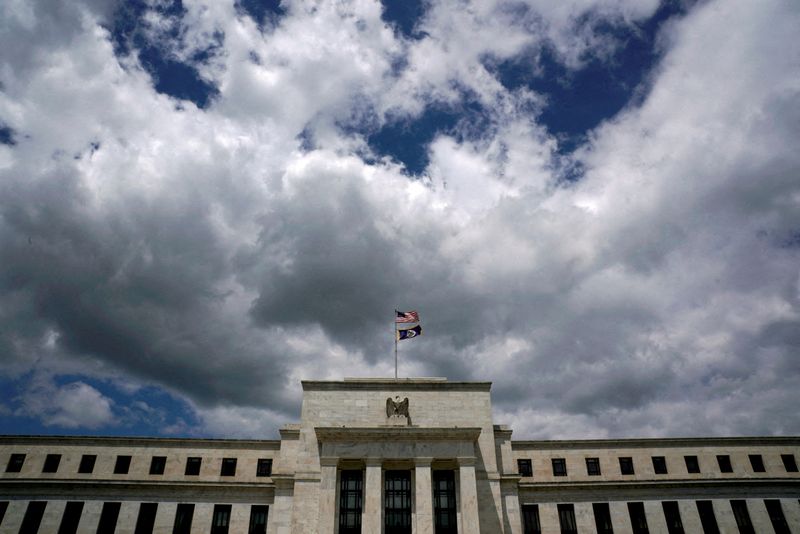
© Reuters. FILE PHOTO: Flags fly over the Federal Reserve Headquarters on a windy day in Washington, U.S., May 26, 2017. REUTERS/Kevin Lamarque/File Photo
APO
+1.47%
Add to/Remove from Watchlist
Add to Watchlist
Add Position
Position added successfully to:
Please name your holdings portfolio
Type:
BUY
SELL
Date:
Amount:
Price
Point Value:
Leverage:
1:1
1:10
1:25
1:50
1:100
1:200
1:400
1:500
1:1000
Commission:
Create New Watchlist
Create
Create a new holdings portfolio
Add
Create
+ Add another position
Close
By Jamie McGeever
ORLANDO, Florida (Reuters) -The Federal Reserve may have lopped more than $1 trillion off its balance sheet but it’s difficult to envisage a scenario where its bond holdings return to anywhere near pre-pandemic or pre-2008 levels.
If several trillion dollars worth of assets held by the Fed effectively act as a permanent liquidity infusion into the economy, the corollary is that interest rates may remain structurally higher than otherwise expected.
It’s a policy framework the Fed has molded since the Great Financial Crisis, amassing a $9 trillion balance sheet, and tweaked since the pandemic by raising rates at the fastest pace in 40 years to quell the highest inflation in 40 years.
“Central banks are going to look at this thinking this world of higher real rates, a higher rates structure, and a bigger balance sheet actually works better,” David Zervos, chief market strategist at Jefferies said at the iConnections Global Alts conference in Miami last week.
The Fed is preparing the ground for rate cuts this year, and is also signaling that it could soon end its ‘quantitative tightening’ program. Zervos estimates QT will stop with the Fed’s balance sheet still at least $7 trillion.
“That’s a colossal balance sheet … a huge stimulus. It lifts earnings, lifts nominal GDP, lifts profits and lifts valuations. We’re going to leave that there, and offset it by running higher interest rate structures,” Zervos said.
The Fed’s balance sheet stands at $7.76 trillion, some 35% of GDP, down from a peak of $9 trillion or 41% of GDP in 2022. Pre-pandemic these figures were $4.2 trillion and 20% of GDP, respectively, and pre-2008 they were $900 billion and 5.5% of GDP.
Speaking on another panel at iConnections, John Zito, partner and deputy CIO of Credit at Apollo Global Management (NYSE:APO), said investors should get used to the Fed’s permanent and powerful market presence, whether they like it or not.
“We’ve already left the game of actually trying to de-lever. I think it’s going to be very hard,” Zito said.
You only have to look at how the Fed’s balance sheet expansion and tightening phases since 2008 have run: around $8 trillion expansion against $2 trillion ‘QT’. Like the Hotel California, the Fed can check out any time it likes but it can never leave.
A TRILLION HERE, A TRILLION THERE
The notion of the Fed operating a permanently large balance sheet should not come as a surprise. Dallas Fed President Lorie Logan, who previously managed the New York Fed’s huge portfolio of securities, recently signaled that QT could end soon.
“Normalizing the balance sheet more slowly can actually help get to a more efficient balance sheet in the long run,” Logan said in January.
William Dudley, former president of the New York Fed, says a big balance sheet is now effectively a core feature of the central bank’s policymaking tool kit.
Speaking to the Financial Times in November, Dudley said paying interest on bank reserves, which the central bank was first allowed to do in the white heat of the Great Financial Crisis in 2008, was the game-changer.
It allows the Fed to buy bonds and influence longer-term borrowing costs, offer open-ended liquidity facilities, and set the policy rate all at the same time.
Before 2008, the Fed had to get the amount of cash in the system at the specific level required to deliver its target policy rate. Essentially, it was aiming for the quantity of money in the system rather than the rate of interest itself.
“Now that we’ve switched to an excess reserves regime, the balance sheet can be as big as you want, and you can still set interest rates where you want. There’s no tension between the two things,” Dudley said.
Nominal and real policy rates are currently 5.25-5.50% and around 2.5%, respectively. The last time they were at these levels was in the run-up to the 2008 crisis but the Fed’s balance sheet was tiny – barely 5% of GDP – and static.
However, not everyone agrees with Zervos at Jefferies that a bigger Fed balance sheet is automatically stimulative, especially when liquidity is already so plentiful.
Many analysts argue that it is the rate of change in market liquidity that affects investor behavior and asset prices rather than the absolute level of liquidity. What matters is flow, not the stock.
“An extra trillion or two of bank cash liquidity just doesn’t have much impact when there is already so much already there,” says Bob Elliott, co-founder of Unlimited Funds and a former investment executive at Bridgewater.
(The opinions expressed here are those of the author, a columnist for Reuters)
(By Jamie McGeever; editing by Philippa Fletcher)
Source: Investing.com


























